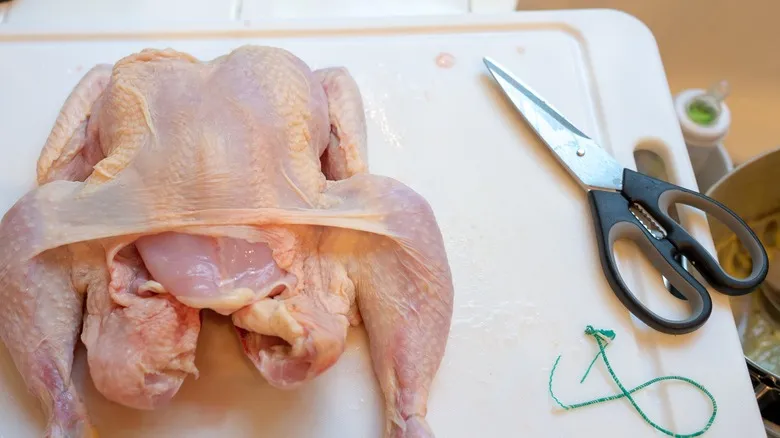1. Slicing pizza the Italian way

An unconventional yet effective method for cutting pizza is to use kitchen shears. It’s time to say goodbye to pizza cutters, large knives, and other methods you’ve relied on. The issue with knives and pizza cutters is that they often drag the toppings along with them. You’ve probably faced the frustration of pulling a pizza from the oven, allowing it to cool, and then trying to slice it into eight perfect pieces. If the pizza is still too hot or overly gooey, you’re likely to create a bit of a mess. Cheese may stick to other slices, the crust may resist, and the cuts will be anything but neat.
Once your pizza has cooled to a manageable temperature, you can easily snip through the layers of deliciousness with kitchen shears. As noted by Food & Wine, the practice of using scissors for pizza isn’t just for convenience; it originated in pizzerias where chefs would ask customers how large they wanted their slices. Scissors make it much easier to cut the ideal piece. So, the next time you’re preparing to make a perfect homemade margherita pizza, grab your shears and cut the slices to order. Pro tip: Kitchen shears are also fantastic for other cheesy dishes for the same reason—think grilled cheese and quesadillas.
2. Opening whole canned tomatoes
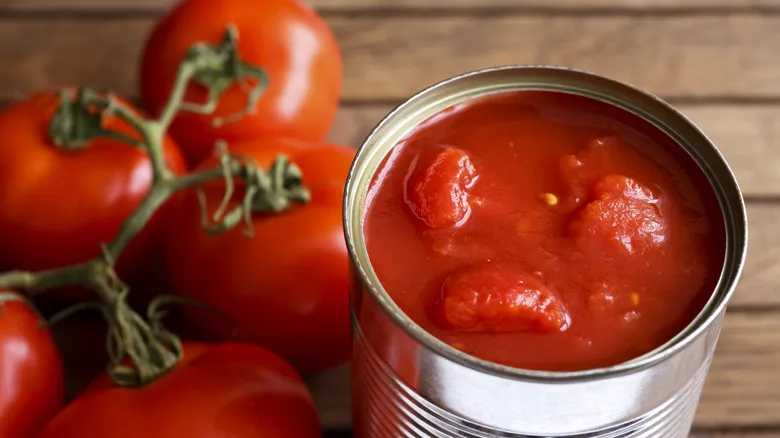
If you've ever tackled a recipe that requires whole canned tomatoes, you know the hassle that comes with them. These fruits (or vegetables, depending on your perspective) are steamed, peeled, and packed into cans, ready for your culinary creations. However, unless you enjoy a bit of textural adventure and don’t mind the occasional splash of tomato juice across your kitchen, this pantry essential can be quite messy when it comes to breaking them down for your dish.
Kitchen shears offer the ideal solution to your canned tomato dilemma, allowing you to easily chop and slice them right in the can. Simply open the can as you usually would, remove the lid, and insert your kitchen shears to start cutting. This method keeps the tomato juice contained, prevents messy hands, and avoids staining your countertops, cutting boards, or clothing.
3. Breaking down chicken, quail, and turkey
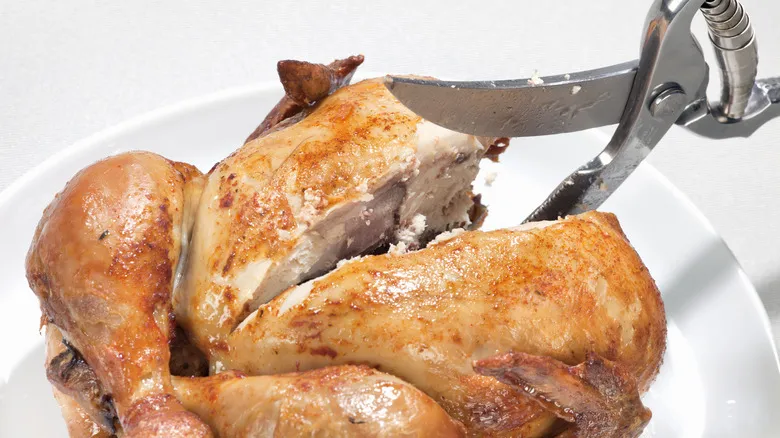
For those who may not feel entirely at ease with the skill of butchery, the thought of using a sharp knife to dissect a chicken, turkey, or quail can be intimidating. Figuring out where to position the knife, which cuts to make, and how to avoid damaging the bird can feel like quite a challenge.
Fortunately, this is where your kitchen shears come in handy. Using a knife can lead to slipping on the slick skin of the chicken. If you're in the mood to prepare spatchcock chicken at home, this technique allows for quicker and easier cooking compared to roasting a whole bird. To spatchcock, you need to remove the backbone, which might be a breeze for someone like Gordon Ramsay, but can be quite tricky for those of us who don’t spend our days in professional kitchens. Grab your shears and simply snip out the spine of the bird, then you can proceed with your recipe. Shears are also great for purchasing whole roasters and breaking them down yourself, making it one of the most economical ways to enjoy poultry.
4. Cutting up hot peppers without touching them

Imagine you're craving chili. You've browned your chuck, ground beef, or turkey, and gathered your tomatoes, chili powder, and spices—now it's time to add some heat. You might want to explore one of these 39 jalapeño recipes, or perhaps substitute with habaneros, or use serranos or poblanos. Each type of pepper has its role in chili, but the cutting, chopping, and prepping can be a bit nerve-wracking. Forgetting to wash your cutting board, knife, or hands after handling the peppers could lead to a swollen eye, burning skin, and other unpleasant reactions.
Kitchen shears can be a game changer when it comes to handling hot peppers. You can easily break down your peppers by removing the top and stem, then slicing into the pepper to take out the veins and seeds. This can all be done directly over a trash can, so you won’t dirty a cutting board or countertop. After that, you can effortlessly cut, snip, and chop your peppers right into the simmering pot of chili. Since your hands will only touch the outer skin of the pepper, you’ll still need to wash up afterward, but you’ll minimize the risk of pepper juice getting on your fingers.
5. Cleaning shrimp
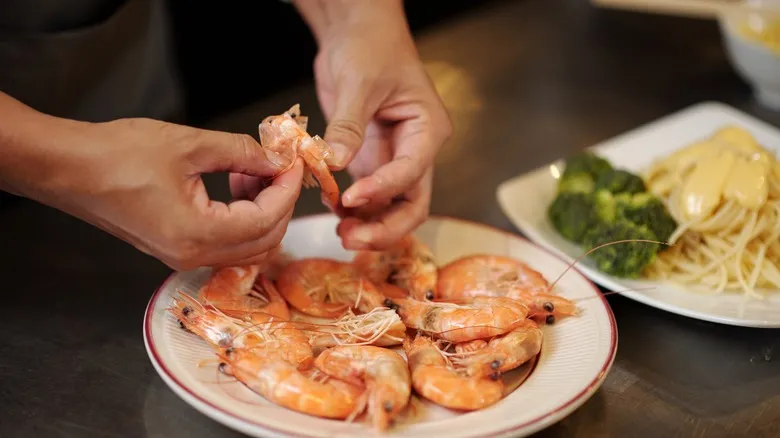
Recipes featuring shrimp, such as shrimp and grits, grilled shrimp, shrimp po' boys, and blackened shrimp, offer a delicious and versatile protein that every home cook should master. However, the process of cleaning and deveining shrimp can be a bit tricky. This is where kitchen shears come in handy, as they provide precision for this task.
You can efficiently peel and devein shrimp simultaneously, especially with medium to large shrimp. Start by placing your thawed or fresh shrimp, still in their shells, in a large bowl in the sink. Turn on the cold water, and working with one shrimp at a time, hold it under the running water while using your kitchen shears. Carefully slide the shears under the shell along the shrimp's back, cutting up along what would be its spine. This method not only removes the shell but also eliminates the vein, resulting in a cleaner taste that you and your guests will enjoy. Additionally, your shears can be used to crack the shells and claws of larger crustaceans like lobsters, crabs, and prawns.
6. Opening your wine bottle
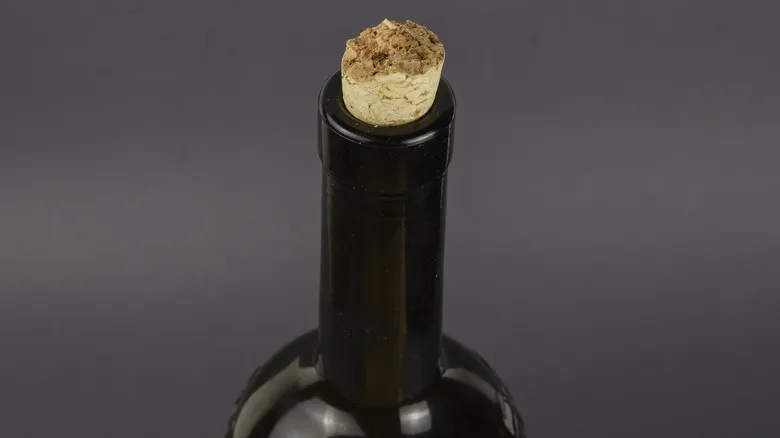
There's nothing more frustrating than wanting to enjoy a great bottle of wine but being unable to open it. Whether the cork is stuck, the screw cap is damaged, or you're dealing with some other fancy closure, it can be a real hassle. Sure, you could try saber-ing the top off, enlist a strong friend to help, or simply give up and reach for a beer. But if you have a pair of kitchen shears handy, you're in luck.
This wine bottle opening trick doesn't actually use the scissors; instead, we’ll take advantage of the serrated edge located between the handle and the blades. If you've broken the cork and there's still enough left above the rim, you can use this tool to grip and twist the remaining piece of cork, hopefully allowing you to uncork your wine. It can also assist in removing stubborn metal caps, so either way, you'll be sipping wine in no time.
7. Chopping up dried fruit
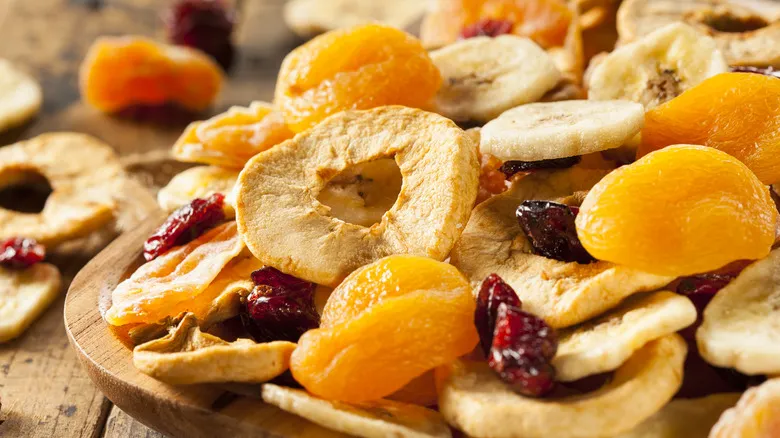
If you're craving tasty, juicy apricots and dried plums, preparing your own trail mix, or finally attempting your grandmother's fruit cake recipe, you'll require a good amount of dried fruit. However, chopping a large quantity of dried fruit can be tedious and frustrating. Dried figs might cling to your knife, and cutting dried mango into manageable pieces can be quite a challenge. Overall, dicing and slicing all those small pieces can be a hassle.
Using kitchen shears to handle dried fruit can simplify the process. If your shears are sharp and in good condition, you can stack flatter pieces of fruit, like apricots, pineapple rings, or mangoes, and cut several at once directly over a bowl for convenience. Additionally, you can try dusting your kitchen shears with a little flour to prevent the dried fruit from sticking to the scissors (or to each other), making it easier to cut the fruit into the desired size for your recipe.
8. Peeling potatoes like a pro
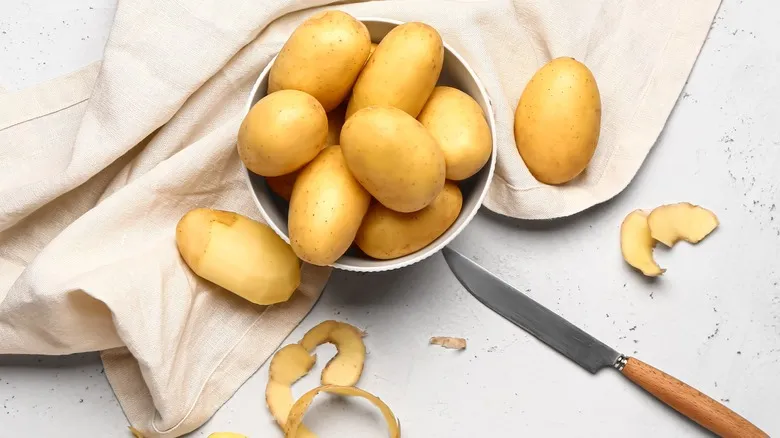
There’s nothing quite as frustrating in the kitchen as peeling potatoes. For a small family meal, prepping a few potatoes doesn’t take much time. However, if you find yourself on potato peeling duty for a big occasion like Thanksgiving, you could be facing a mountain of spuds. That means a lot of peeling, a mess of potato scraps on the floor, and the risk of injuring yourself while trying to clean them.
Fortunately, there’s a little-known trick that can significantly reduce your potato peeling time. Instead of using a peeler, grab your trusty kitchen shears. Start by washing your potatoes, then use the shears to cut a line around the entire circumference of each potato. Make sure the cut goes all the way around to allow the skin to separate easily. After scoring the potatoes, place them in a pot of boiling water for about 20 minutes. Once done, transfer them to an ice bath for about five minutes to cool them down enough to handle. When they’re cool, take them out of the ice bath and gently pull the skins off each end. You might need to apply a bit of pressure, but the skins should come off easily. And don’t forget, you can save those skins for delicious loaded potato skin recipes!
9. Opening those tough-to-get jars
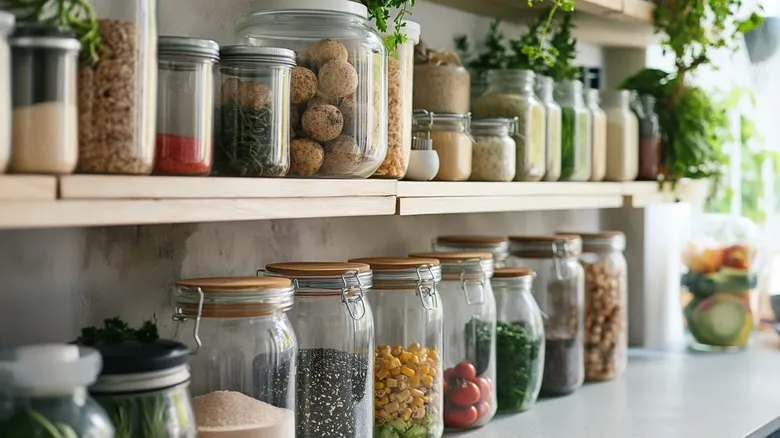
If you've faced your fair share of challenges with everything from stubborn pickle jars to unyielding curry containers and jam jars, a pair of kitchen shears might be just what you need. Glass jars with metal lids are infamous for getting stuck. One effective method for opening these difficult containers is to run the lid and the area around the jar's closure under hot water. The heat causes the metal lid to expand slightly, making it easier to remove. However, be prepared to get a little wet, and since you're working with hot water, some discomfort may be unavoidable.
If the hot water method isn't feasible, hopefully, you have your kitchen shears handy. By using the metal teeth grippers located above the blade and below the handle, you can firmly grip that stubborn lid and twist it off. This technique provides you with extra leverage to successfully open the jar.
10. Cracking open nuts
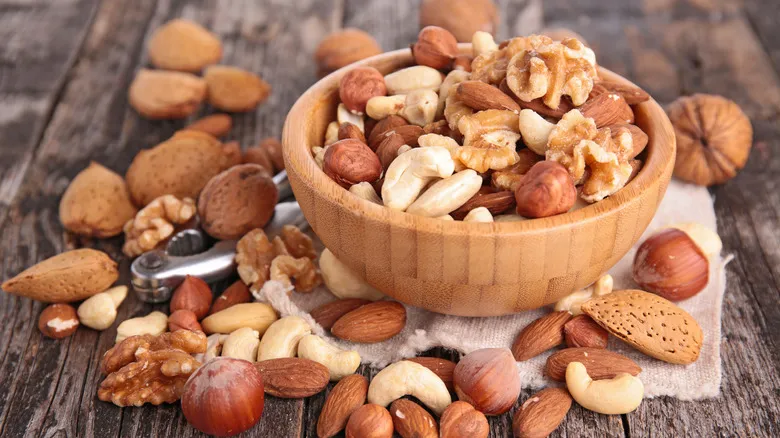
Once a year, an army of nutcrackers gazes back at me from the mantelpiece, their overly bright teeth shining white, poised to crunch down on the chestnuts roasting in the fire below. However, outside the holiday season, you might find yourself needing assistance to crack everything from walnuts to chestnuts to Brazil nuts. While those nutcrackers are charming, they aren't the most effective tools for tackling a whole batch of nuts. They often prioritize style over practicality. Your kitchen shears, on the other hand, are ready and capable, even if they lack the same flair.
To use your shears, take advantage of the serrated teeth located between the blades and handles (the same ones you’d use for opening jars). Position your nut of choice and apply pressure to crack it open. This method should swiftly remove the outer shell of most nuts. Once shelled, these nuts can be used fresh in a variety of recipes or stored in the freezer for later use.
11. Squeezing lemons

On a sweltering summer day, with temperatures climbing into the 90s and no relief in sight, a large, chilled glass of lemonade is the epitome of refreshment. Sure, you could go to the store and grab a pre-made version, or opt for the powdered mix, which might not be as enticing for some. However, the "best" lemonade, in our opinion, is the one made from scratch using water, freshly squeezed lemons, and a touch of sugar. The downside is that manually juicing lemons can be quite time-consuming.
If you're finding it challenging to juice lemons, your kitchen shears can come to the rescue. Just cut the lemon in half, then squeeze each half over a bowl using the handle of the shears. This design allows you to apply more pressure while juicing. And don’t limit this handy trick to lemons; you can easily use it for grapefruits, limes, pomelos, oranges, or any other fruit that requires juicing.
12. Cutting items already in the pan
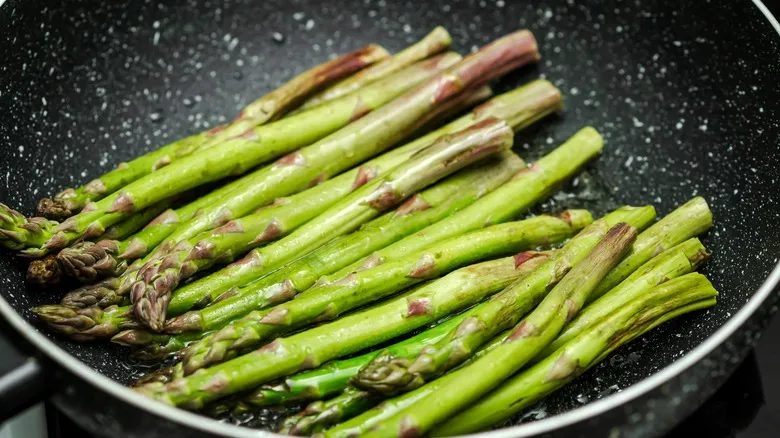
Imagine you have a sizzling pan on the stove, already busy cooking long strips of vegetables or meat. They're bubbling away, but you notice they're not quite bite-sized. While larger pieces of protein or veggies aren't a disaster, achieving uniform sizes is crucial, especially when preparing meals for kids or trying to avoid awkward bites. However, removing the food from the pan, chopping it on a cutting board, and then returning it can be a tedious, messy process that interrupts your cooking.
This is where kitchen shears come in handy. With these handy tools, you can easily snip and cut your ingredients right in the hot pan. Just be sure to protect your hands from the heat and avoid scratching the bottom of the pan with the sharp tips of the blades. Snip away until you reach your desired size! This technique works particularly well with vegetables like asparagus, green beans, and broccolini, but if you're feeling adventurous, you can use it on just about anything.
Recommended

What Does It Mean To Glaze A Fish Before Freezing It?
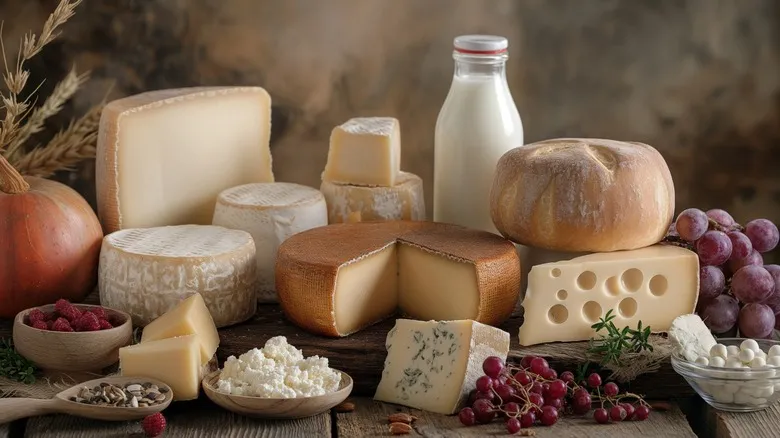
How To Store Stinky Cheese To Keep It Fresh And Its Smell Contained

The One Frozen Veggie Vegans Should Always Have In The Freezer

The Best And Worst Types Of Meat To Cook In The Air Fryer
Next up

